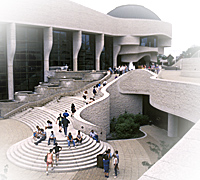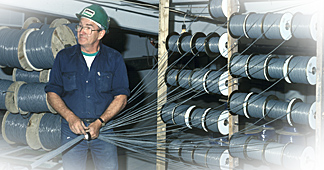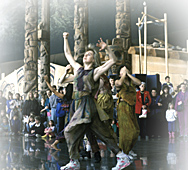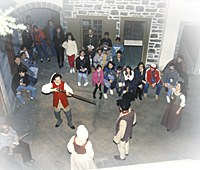FULL TOUR
Conceiving a National
Museum - A WORLD-CLASS MUSEUM
The building to house the museum
has been recognized, at home and abroad, as a world-class
structure. Bigger and more complex than originally planned,
it is a building unlike any other. The structure is 'geoform':
its features are drawn directly from the landscape and the
forces of nature which shaped the landscape. By contrast, it
embodies many state-of-the-art technologies: from the evolution
of its form within the "womb" of a computer's memory,
through its nourishment and protection by computer-controlled
environmental and security systems, to its nervous system made
up of fibre-optic cables.
The building was designed by architect
Douglas J. Cardinal. His architectural style is characterized by
sinuous, flowing lines. The naturalistic qualities of his
creations make them at once provocative and restful.
© Canadian Museum of Civilization, D2004-18588, CD2004-1377
|

|
The only valid response CMC's staff could give to a world-class
structure, and to the substantial investment of public funds in
the project, was to "sculpt" a prototype for an indoor
human history museum of a quality that makes it a source of
national pride. Much effort was devoted to gathering information
on the best new developments in museums and related institutions
worldwide. CMC's own experiences and practices also proved an
invaluable foundation, but they were not unquestioningly
perpetuated. Curatorial operations, exhibitions, interpretive
and educational programmes were re-evaluated and, wherever
desirable, reshaped as resources allowed.

A major museum such as the CMC must be
planned to serve not only today's society, but also tomorrow's.
Therefore, the architectural shell contains a complex web of
fibre-optic cables, all linked to a high-tech network centre,
thus enabling information of all types to be channelled from
museum data banks to knowledge seekers both inside and outside
the museum.
© Canadian Museum of Civilization,
S2004-1239, CD2004-1376
|
The CMC can perform on a more sophisticated level and at a
greater capacity than was expected when the project was begun. A
fundamental tenet guiding the architects of museum function was
that their product should be user-driven not producer-driven.
The main aim for the exhibitions has been to give the artifacts
context. This meant re-creating the cultural settings
appropriate to the displayed objects, supporting them by dynamic
programmes that have cultural relevance, and enhancing the
experience by interactivity that draws visitors into a more
intimate and meaningful relationship with the presentations.
 
The Grand Hall (left) provides a striking setting
for large-scale cultural performances, while the Canada Hall (right)
incorporates several spaces suitable for more intimate
presentations by the Museum's theatre company, Dramamuse.
© Canadian Museum of Civilization,
D2004-18603 (left),
S94-11986 (right), CD2004-1377
|


|